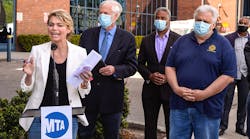NYC Mayor Eric Adams lays out plan to address mental illness and the unhoused in subways
New York City Mayor Eric Adams outlined his Subway Safety Plan, which aims to tackle some of society’s most pressing challenges - homelessness and serious mental illness – and how they are addressed and aid provided within the city’s subway system.
The plan includes fair and transparent enforcement of the Metropolitan Transportation Authority’s (MTA) code of conduct, as well as increasing outreach personnel and services available to those in need.
“It is cruel and inhumane to allow unhoused people to live on the subway, and unfair to paying passengers and transit workers who deserve a clean, orderly and safe environment,” said Mayor Adams. “The days of turning a blind eye to this growing problem are over, and I look forward to collaborating with the state, the federal government, [Transport Workers Union], advocates and law enforcement to solve this challenge. It will take time, but our work starts now.”
The plan calls for addressing “these concurrent, and sometimes, interconnected, crises” by working with partners including the MTA, state of New York and federal officials to invest resources that bridge “gaps in the system where too many have been lost.”
People – Places – Policies
The plan calls for investments into three buckets – people, places and policies. The city, working with MTA and other New York state entities, will invest in people to provide immediate support and protection to New Yorkers, while investments in places will include drop-in-centers, safe havens, stabilization beds and Street Homeless Outreach Wellness vans. The third area of investment covers policies and is designed to bring changes at local, state and federal levels to provide medium- and long-term solutions. These include:
- Deploying up to 30 Joint Response Teams that bring together DHS, the Department of Health and Mental Hygiene, NYPD and community-based providers in high-need locations across our city.
- Training NYPD officers in the subway system to enforce the MTA and New York City Transit Authority’s rules of conduct in a fair and transparent way.
- Expanding Behavioral Health Emergency Assistance Response Division “B-HEARD” teams to six new precincts, more than doubling the precincts covered to 11. These teams will expand on the already-successful pilot of answering non-violent 911 mental health calls with mental health professionals.
- Incorporating medical services into DHS sites serving individuals experiencing unsheltered homelessness. Expanded DHS Safe Havens and stabilization bed programs will offer on-site physical and behavioral health care to immediately address clients’ needs.
- Immediately improving coordination across government with weekly “Enhanced Outreach Taskforce” meetings that bring together senior leaders from 13 city and state agencies to address issues quickly.
- Creating new Drop-in-Centers to provide an immediate pathway for individuals to come indoors and exploring opportunities to establish Drop-in-Centers close to key subway stations to directly transition individuals from trains and platforms to safe spaces.
- Streamlining the placement process into supportive housing and reducing the amount of paperwork it takes to prove eligibility.
- Calling on state government to expand psychiatric bed resources and amending Kendra’s Law to improve mental health care delivery for New Yorkers on Assisted Outpatient Treatment.
- Requiring — instead of requesting — everyone to leave the train and the station at the end of the line.
“Improving subway safety and succeeding in providing innovative solutions to meaningfully help some of the most vulnerable New Yorkers requires a comprehensive, multi-agency approach,” said NYPD Police Commissioner Keechant Sewell. “This plan represents the best of that kind of smart, seamless, collaborative work and also reinforces the NYPD’s core philosophies for public safety by ensuring people abide by all applicable laws and transit rules, while simultaneously connecting people in need to the critical services they deserve.”
State funding
"For too long our mental healthcare system suffered from disinvestment, and the pandemic has only made things harder for New Yorkers with serious mental illness who are experiencing homelessness," New York Gov. Kathy Hochul said. “We must work together to keep our subways -- the lifeblood of New York City -- safe for all riders, and to get help and services to those in need."
The governor highlighted additional funding she has proposed to improve mental health care in the state.
The governor has committed to investing $27.5 million annually to increase funding for inpatient psychiatric beds. The governor notes there has been a shortage of psychiatric beds in New York City and across the state due to lower Medicaid reimbursement. The additional funds would increase the reimbursement by 20 percent and bring additional beds online for psychiatric use, including more than 600 in New York City.
Gov. Hochul is also committing $9 million annually to recruit psychiatrists and psychiatric nurse practitioners; fields that are experiencing a national shortage.
The third area the governor pledged financial support is in providing transitional housing. The governor committed to investing $12.5 million annually for 500 additional supportive housing eds to transition those in crisis to stable housing.
The governor’s office notes these funding commitments build on the $10 billion plan proposed to improve the health care systems, which includes a $577-million increase for community mental health programs and services.
MTA Chair and CEO Janno Lieber called the efforts of Mayor Adams and Gov. Hochul “a game changer.”
“Now, with additional strategies on how to enforce system rules and provide services to vulnerable New Yorkers, we are standing up for millions of riders who want to see change. Together with a CompStat-style metrics-based approach to tracking progress, we can fix these conditions and be in a position to welcome back more and more New Yorkers to a safe subway system,” said Lieber.
Mayor Adams recognizes a well-developed plan and robust investment still requires time. The conclusion of the Subway Safety Plan reads “we will not solve a decades-long crisis overnight.” But the plan says the city and its partners can deliver on both public safety and justice.
“We can build a better system. We can build a system in which helping a New Yorker off our streets, trains, or subway stations is the first step in a new journey, from outreach to housing to ongoing care and a true sense of community all coordinated seamlessly by the city. We will be there for each other. We will build a better city, together,” the plan includes in its conclusion.
---------------
A link to the 17-page Subway Safety Plan is provided here.

Mischa Wanek-Libman | Group Editorial Director
Mischa Wanek-Libman is director of communications with Transdev North America. She has more than 20 years of experience working in the transportation industry covering construction projects, engineering challenges, transit and rail operations and best practices.
Wanek-Libman has held top editorial positions at freight rail and public transportation business-to-business publications including as editor-in-chief and editorial director of Mass Transit from 2018-2024. She has been recognized for editorial excellence through her individual work, as well as for collaborative content.
She is an active member of the American Public Transportation Association's Marketing and Communications Committee and served 14 years as a Board Observer on the National Railroad Construction and Maintenance Association (NRC) Board of Directors.
She is a graduate of Drake University in Des Moines, Iowa, where she earned a Bachelor of Arts degree in Journalism and Mass Communication.



